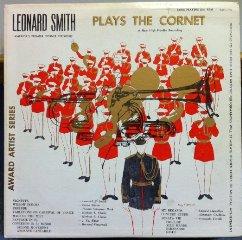Leonard Smith Plays The Cornet (1960)
Leonard Smith Plays The Cornet (1960)

1. Arcangelo Corelli - Sonata VIII (arr Magnini) 2. Leonard Smith – Vignette 3. Frank Simon - Willow Echoes 4. J. S. Bach – Prelude 5. H. L.Clarke - Variations on 'Carnival of Venice' 6. H. L.Clarke - Maid of the Mist 7. J. Ed. Barat – Fantasie 8. Bernard Fitzgerald - Andante Cantabile from Concerto in Ab Minor 9. Edward Llewellyn - My Regards 10. Alexander Goedicke - Concert Etude Leonard Smith – Cornet Bernard Leighton – Piano
Leonard B. Smith (1915-2002) began the study of cornet at the age of 8, studying under Ernest S. Williams and performing in many ensembles. Smith won a scholarship to the New York Military Academy, in whose band he played; he also became a noted performer with the Georges Barrere Little Symphony. He attended summer band camp at the Ernest S. Williams School of Music in Saugerties, NY, where he expanded his musical abilities into the areas of composition, arranging, and conducting.
In 1936, when cornetist Del Staigers vacated his position as cornet soloist of the famed Goldman Band, Williams contacted Edwin Franko Goldman and recommended Leonard B. Smith. As the Goldman Bands season encompassed only the summer months, Smith auditioned for the Detroit Symphony, winning the principal trumpet position. At the time the Detroit Symphony performed 39 weeks per season on radio broadcasts of the Ford Sunday Evening Hour. During this time Smith played under and became acquainted with many of the leading conductors of the day, including Eugene Ormandy and Fritz Reiner. He continued to play in the summers with Goldman and in winters with the Symphony through 1941. During this time, it was the trumpeting of Leonard B. Smith that opened weekly radio broadcasts of the popular Lone Ranger broadcasts for many years.
Upon the start of the Second World War, Smith enlisted in the United States Navy, assigned first with the Philadelphia Navy Yard Band and soon thereafter, with the U. S. Navy Band in Washington, D.C. He continued to perform solos on many Navy Band broadcasts and concerts. While serving in the military, the Detroit Symphony had replaced the first trumpet, and Goldman had secured a new soloist. This provided Smith with the opportunity to form his own concert band in Detroit, which gave its first concert in 1946. Known variously through the years as the Leonard Smith Band and the Belle Isle Concert Band, it is best remembered today as the Detroit Concert Band. The band recorded 31 LP albums, including the complete published marches of John Philip Sousa, and became the pre-eminent civilian concert band of its time.
For the next thirty-five years, Smith performed cornet solos and trios with his own band, and became a frequent clinician and guest soloist/conductor with hundreds of school, college and community bands. He composed dozens of brass solos and ensembles and served as a consultant for a popular band method book. The Reynolds Co. designed and manufactured a Leonard Smith model cornet, and throughout this era he was known as Americas Premier Cornet Soloist. During his performing career, Smith recorded professionally as a cornet soloist for 45 years, and appeared in public as soloist on thousands of occasions. He is generally regarded as one of the most consistent and accomplished cornet and trumpet artists of his day, and the great champion of the classic concert band in the second half of the twentieth century.
Smith passed away on July 23, 2002, in Scottsdale, Arizona. --- digital.lib.umd.edu
download (mp3 @320 kbs):
uploaded yandex 4shared mega mediafire solidfiles zalivalka cloudmailru oboom








